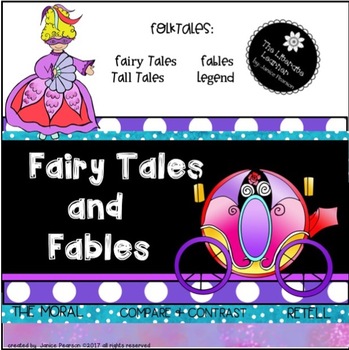Read and Write About Folktales, Fables and Fairy Tales 2nd and 3rd Grade
- PDF
- Easel Activity
What educators are saying
Description
Teach the similarities and differences in folktales: fairy tales, fables, tall tales and legends. Use for close reading or guided reading lessons with a focus on
Retell
Determine Moral
Compare and Contrast
Write Your own Folktale
The unit can be taught as individual topics or taught as a whole. Activities supplement your classroom instruction while while students learn to compare and contrast two fairy tales from two different cultures. (RL2.9) Additional lessons focus on retelling folktales or fables and on identifying the moral or lesson in the story. (RL 2.2)
Plan and Write your own Folktale" templates are included. (W2.3)
I have included a digital friendly version which you can change to fit your needs. For the fairy tales and fables I have chosen the shorter version of each text for digital use. However, you can make changes as you need for your students. Teacher notes, lesson ideas and answer keys are downloadable in the PDF but not included in the digital one you would use with students.
Included:
Classroom and student posters: What is a Folktale? Fairy Tale? Fable? Tall Tale?
Legend?
Worksheets, Vocabulary Lists, Story Maps, Text-Dependent Questions and
Assessments; Blank copies to use with any story
Eight Stories: Eight original or adapted stories
+ 5 additional shorter and less complex versions of fairytales and fables for classroom differentiation.
A Folktale: The White Wolf (A folktale from the southwest)
Fairy Tales: Two Cinderella Stories
Fables: A Lion and the Mouse fable
The City Mouse and the Country Mouse
The Diamond and the Dragon(An original fable)
A Tall Tale: Johnny Appleseed
A Legend: The Legend of King Arthur Text-dependent questions are provided and can
be used as assessments.
Three additional assessments: What Kind of a Story is it?
Answer Keys provided when applicable.
-- -- -- --
How to get TPT credit to use on future purchases: • Please go to your My Purchases page (you may need to login). Beside each purchase you'll see a Provide Feedback button. Simply click it and you will be taken to a page where you can give a quick rating and leave a short comment for the product. Each time you give feedback, TPT gives you feedback credits that you use to lower the cost of your future purchases. I value your feedback greatly as it helps me determine which products are most valuable for your classroom so I can create more for you. Be the first to know about my new discounts, freebies and product launches:
• Look for the green star next to my store logo and click it to become a follower. You will now receive email updates about this store.






